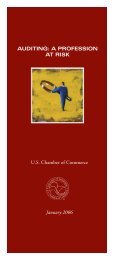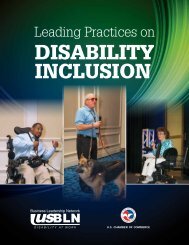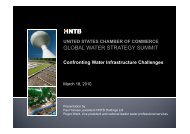Trends in Union Corporate Campaigns - US Chamber of Commerce
Trends in Union Corporate Campaigns - US Chamber of Commerce
Trends in Union Corporate Campaigns - US Chamber of Commerce
Create successful ePaper yourself
Turn your PDF publications into a flip-book with our unique Google optimized e-Paper software.
TRENDS IN UNION<br />
CORPORATE CAMPAIGNS<br />
A Brief<strong>in</strong>g Book<br />
Jarol B. Manheim<br />
The George Wash<strong>in</strong>gton University<br />
The U.S. <strong>Chamber</strong> <strong>of</strong> <strong>Commerce</strong>
TRENDS IN UNION<br />
CORPORATE CAMPAIGNS<br />
A BRIEFING BOOK<br />
Jarol B. Manheim<br />
The George Wash<strong>in</strong>gton University
A “corporate campaign” is an attack by a union on the ability <strong>of</strong> a<br />
company or <strong>in</strong>dustry to conduct its rout<strong>in</strong>e bus<strong>in</strong>ess. The objective<br />
is to generate so much pressure on the “target” that it will give<br />
<strong>in</strong> to union demands. This brief<strong>in</strong>g book provides the reader with<br />
an <strong>in</strong>troduction to the corporate campaign and an overview <strong>of</strong> its<br />
<strong>in</strong>creas<strong>in</strong>gly important role <strong>in</strong> U.S. labor relations.<br />
Jarol B. Manheim is Pr<strong>of</strong>essor <strong>of</strong> Media and Public Affairs, and <strong>of</strong> Political<br />
Science, at The George Wash<strong>in</strong>gton University, where he was the found<strong>in</strong>g director<br />
<strong>of</strong> the School <strong>of</strong> Media and Public Affairs. He has been described as one <strong>of</strong> the<br />
world’s lead<strong>in</strong>g authorities on campaigns aga<strong>in</strong>st bus<strong>in</strong>ess. Among his books<br />
on the subject are The Death <strong>of</strong> a Thousand Cuts: <strong>Corporate</strong> <strong>Campaigns</strong><br />
and the Attack on the Corporation (Lawrence Erlbaum Associates, 2001),<br />
Biz-War and the “Out-<strong>of</strong>-Power Elite”: The Progressive Left Attack on<br />
the Corporation (Lawrence Erlbaum Associates, 2004), and Power Failure,<br />
Power Surge: <strong>Union</strong> Pension Fund Activism and the Publicly Held<br />
Corporation (HR Policy Association, 2005).<br />
The United States <strong>Chamber</strong> <strong>of</strong> <strong>Commerce</strong> is the world’s<br />
largest bus<strong>in</strong>ess federation, represent<strong>in</strong>g 3,000,000<br />
bus<strong>in</strong>esses, 2,800 state and local chambers <strong>of</strong> commerce,<br />
830 bus<strong>in</strong>ess associations, and 102 American <strong>Chamber</strong>s<br />
<strong>of</strong> <strong>Commerce</strong> <strong>in</strong> 87 countries.<br />
©2005 U.S. <strong>Chamber</strong> <strong>of</strong> <strong>Commerce</strong>
TABLE OF CONTENTS<br />
EXECUTIVE SUMMARY . . . . . . . . . . . . . . . . . . . . . . . . . . . . . . . . . . .5<br />
INTRODUCTION . . . . . . . . . . . . . . . . . . . . . . . . . . . . . . . . . . . . . . .7<br />
ORIGINS . . . . . . . . . . . . . . . . . . . . . . . . . . . . . . . . . . . . . . . . . . . . .9<br />
STRATEGY . . . . . . . . . . . . . . . . . . . . . . . . . . . . . . . . . . . . . . . . . . 13<br />
OBJECTIVES . . . . . . . . . . . . . . . . . . . . . . . . . . . . . . . . . . . . . . . . . .21<br />
CORPORATE TARGETS . . . . . . . . . . . . . . . . . . . . . . . . . . . . . . . 27<br />
TRENDS . . . . . . . . . . . . . . . . . . . . . . . . . . . . . . . . . . . . . . . . . . . . .31<br />
CONCL<strong>US</strong>ION . . . . . . . . . . . . . . . . . . . . . . . . . . . . . . . . . . . . . . . .45<br />
ENDNOTES . . . . . . . . . . . . . . . . . . . . . . . . . . . . . . . . . . . . . . . . . 47<br />
<strong>Trends</strong> <strong>in</strong> <strong>Union</strong> <strong>Corporate</strong> <strong>Campaigns</strong><br />
3
EXECUTIVE SUMMARY<br />
This brief<strong>in</strong>g book summarizes the phenomenon known as the<br />
“corporate campaign” and identifies current trends <strong>in</strong> campaign<br />
strategy and tactics. Among the pr<strong>in</strong>cipal observations and f<strong>in</strong>d<strong>in</strong>gs<br />
are the follow<strong>in</strong>g:<br />
• The corporate campaign was <strong>in</strong>vented by the New Left <strong>in</strong><br />
the 1970s, and by the 1990s was <strong>in</strong> widespread use by the labor<br />
movement. To date, unions have waged nearly 300 campaigns<br />
aga<strong>in</strong>st employers, primarily, though not exclusively,<br />
to facilitate organiz<strong>in</strong>g.<br />
• <strong>Corporate</strong> campaigns employ “power structure analysis” to<br />
identify and exploit vulnerabilities <strong>in</strong> the critical stakeholder<br />
relationships on which all companies depend. This broad<br />
strategic approach is then implemented through tactics that<br />
range from highly sophisticated f<strong>in</strong>ancial and governance<br />
<strong>in</strong>itiatives to street theater and even psychological warfare.<br />
• Typically, the role <strong>of</strong> the corporate campaign today is to force<br />
management to accede to union demands for “card check and<br />
neutrality”—a process by which the union certification procedures<br />
adm<strong>in</strong>istered by the National Labor Relations Board<br />
(NLRB) are effectively circumvented. A recent <strong>in</strong>novation here<br />
is the substitution <strong>of</strong> non-NLRB elections for card check, which<br />
has been coupled with a widen<strong>in</strong>g attack on the NLRB itself.<br />
• The use and conduct <strong>of</strong> corporate campaigns has evolved<br />
over time. Some recent trends:<br />
◆ <strong>in</strong>creas<strong>in</strong>g and highly strategic use <strong>of</strong> shareholder resolutions<br />
and proxy vot<strong>in</strong>g to pressure directors and senior management;<br />
<strong>Trends</strong> <strong>in</strong> <strong>Union</strong> <strong>Corporate</strong> <strong>Campaigns</strong><br />
5
◆ cont<strong>in</strong>ued development <strong>of</strong> <strong>in</strong>frastructure (courses, manuals,<br />
fund<strong>in</strong>g mechanisms) to support corporate campaigns,<br />
and a grow<strong>in</strong>g population <strong>of</strong> pr<strong>of</strong>essionals, now number<strong>in</strong>g<br />
<strong>in</strong> the hundreds, whose primary job responsibility is to plan<br />
and lead them;<br />
◆ <strong>in</strong>creas<strong>in</strong>g numbers <strong>of</strong> multi-union, or even movement<br />
wide, attacks on <strong>in</strong>dividual companies, <strong>in</strong>clud<strong>in</strong>g activity<br />
by transnational union alliances and <strong>in</strong>ternational labor organizations;<br />
◆ rapid expansion <strong>of</strong> networks and coalitions <strong>of</strong> nonunion allies<br />
and surrogates that advance and legitimize union attacks on<br />
companies, both with<strong>in</strong> the U.S. and <strong>in</strong>ternationally;<br />
◆ an <strong>in</strong>crease <strong>in</strong> the use <strong>of</strong> corporate campaigns for political,<br />
policy or ideological purposes, rather than for economic/<br />
employment purposes.<br />
This report concludes that corporate campaigns play an important<br />
and grow<strong>in</strong>g role as an alternative to labor-management relations<br />
as envisioned <strong>in</strong> the nation’s pr<strong>in</strong>cipal govern<strong>in</strong>g legislation. Their<br />
cont<strong>in</strong>ued widespread use may have the result <strong>of</strong> render<strong>in</strong>g that<br />
legislation <strong>in</strong>effective or irrelevant.<br />
6<br />
Executive Summary
INTRODUCTION<br />
A corporate campaign is a multifaceted and <strong>of</strong>ten long-runn<strong>in</strong>g<br />
attack on the bus<strong>in</strong>ess relationships on which a corporation<br />
(or an <strong>in</strong>dustry) depends for its well-be<strong>in</strong>g and success. It is a<br />
highly sophisticated form <strong>of</strong> warfare <strong>in</strong> which a target company<br />
is subjected to diverse attacks—legislative, regulatory, legal,<br />
economic, psychological—the function <strong>of</strong> which is to so<br />
thoroughly underm<strong>in</strong>e confidence <strong>in</strong> the company that it is<br />
no longer able to do bus<strong>in</strong>ess as usual. The union wag<strong>in</strong>g the<br />
campaign then <strong>of</strong>fers to withdraw the pressure <strong>in</strong> return for<br />
substantial concessions. These concessions might <strong>in</strong>clude such<br />
items as agreement upon otherwise unacceptable contract terms,<br />
silence with respect to the company’s preferences regard<strong>in</strong>g the<br />
unionization <strong>of</strong> its workforce (what the unions term “neutrality”),<br />
or even an agreement to recognize the union without a formal<br />
vote by the employees. The more sensitive a company is to its<br />
reputation, the more susceptible it is to public fears about the<br />
safety or propriety <strong>of</strong> its operations, or the more highly regulated<br />
its l<strong>in</strong>es <strong>of</strong> bus<strong>in</strong>ess, the more vulnerable it is to such attacks.<br />
In this brief<strong>in</strong>g book, we will summarize the orig<strong>in</strong>s, strategies and<br />
objectives <strong>of</strong> these campaigns, and will identify both long-term<br />
and recent trends <strong>in</strong> their development.<br />
<strong>Trends</strong> <strong>in</strong> <strong>Union</strong> <strong>Corporate</strong> <strong>Campaigns</strong><br />
7
ORIGINS<br />
<strong>Corporate</strong> campaigns trace their orig<strong>in</strong>s to several sources. Two<br />
<strong>of</strong> the most important <strong>in</strong>clude the Students for a Democratic<br />
Society (SDS) and long-time community activist Saul Al<strong>in</strong>sky. In<br />
its def<strong>in</strong><strong>in</strong>g 1962 manifesto, The Port Huron Statement, drafted by<br />
then-president Tom Hayden, the SDS noted:<br />
We can no longer rely on competition <strong>of</strong> the many to<br />
assure that bus<strong>in</strong>ess enterprise is responsive to social<br />
needs…. Nor can we trust the corporate bureaucracy to be<br />
socially responsible or to develop a ‘corporate conscience’<br />
that is democratic…. We must consider changes <strong>in</strong> the<br />
rules <strong>of</strong> society by challeng<strong>in</strong>g the unchallenged politics <strong>of</strong><br />
American corporations. 1<br />
SDS was soon to be swept up <strong>in</strong> the anti-war movement <strong>of</strong> that<br />
era and, with the s<strong>in</strong>gle exception <strong>of</strong> a demonstration organized<br />
<strong>in</strong> 1964 by then-president Todd Gitl<strong>in</strong> and then-vice president<br />
Paul Booth designed to pressure Chase Manhattan Bank to stop<br />
f<strong>in</strong>anc<strong>in</strong>g the Apartheid regime <strong>in</strong> South Africa, did not engage <strong>in</strong><br />
significant anti-corporate activism. 2 But numerous SDS alumni,<br />
<strong>in</strong>clud<strong>in</strong>g Mr. Booth and perhaps most notably Michael Locker,<br />
went on to careers <strong>in</strong> the labor movement, where they helped to<br />
put these strategies <strong>in</strong>to motion.<br />
In the meantime, Mr. Al<strong>in</strong>sky, act<strong>in</strong>g <strong>in</strong>dependently, was already<br />
putt<strong>in</strong>g some <strong>of</strong> these ideas to work, most notably <strong>in</strong> a campaign<br />
he led aga<strong>in</strong>st Eastman Kodak <strong>in</strong> 1966 on behalf <strong>of</strong> a coalition<br />
<strong>of</strong> African-American organizations seek<strong>in</strong>g to open employment<br />
opportunities <strong>in</strong> Rochester, New York. Significantly, Mr. Al<strong>in</strong>sky<br />
chose Kodak as his target, not because it was the worst corporate<br />
citizen <strong>in</strong> town, but because it was the best. He reasoned that the<br />
<strong>Trends</strong> <strong>in</strong> <strong>Union</strong> <strong>Corporate</strong> <strong>Campaigns</strong><br />
9
company was so image conscious that it would be the most likely<br />
to yield to the group’s demands. 3 Of more last<strong>in</strong>g import, however,<br />
was his tactical advice to anti-corporate activists, which, <strong>in</strong> a book<br />
<strong>of</strong> the same name, took the form <strong>of</strong> thirteen “Rules for Radicals.”<br />
They <strong>in</strong>cluded:<br />
1. Power is not only what you have, but what the enemy<br />
th<strong>in</strong>ks you have.<br />
2. Never go outside the experience <strong>of</strong> your people.<br />
3. Whenever possible go outside the experience <strong>of</strong><br />
your enemy.<br />
4. Make the enemy live up to their own book <strong>of</strong> rules.<br />
5. Ridicule is man’s most potent weapon.<br />
6. A good tactic is one that your people enjoy.<br />
7. A tactic that drags on too long becomes a drag.<br />
8. Keep the pressure on.<br />
9. The threat is usually more terrify<strong>in</strong>g than the th<strong>in</strong>g itself.<br />
10. Ma<strong>in</strong>ta<strong>in</strong> a constant pressure upon the opposition.<br />
11. If you push a negative hard and deep enough it will break<br />
through <strong>in</strong>to its counter-side.<br />
12. The price <strong>of</strong> a successful attack is a constructive alternative.<br />
10<br />
Orig<strong>in</strong>s
13. Pick the target, freeze it, personalize it, and polarize it. 4<br />
Mr. Al<strong>in</strong>sky’s book is still <strong>in</strong> pr<strong>in</strong>t today, and is widely regarded as<br />
required read<strong>in</strong>g for corporate campaigners.<br />
<strong>Trends</strong> <strong>in</strong> <strong>Union</strong> <strong>Corporate</strong> <strong>Campaigns</strong><br />
11
STRATEGY<br />
The central strategic concept underly<strong>in</strong>g the corporate campaign<br />
is known as power structure analysis. As characterized by<br />
Ray Rogers, who, with Mr. Locker, is generally credited with<br />
develop<strong>in</strong>g labor’s first corporate campaigns, waged by the<br />
textile workers union aga<strong>in</strong>st Farah Manufactur<strong>in</strong>g and J.P.<br />
Stevens <strong>in</strong> the mid-1970s, power structure analysis is a means <strong>of</strong><br />
“organiz<strong>in</strong>g workers” by “disorganiz<strong>in</strong>g companies.” 5 Or as he<br />
put it on another occasion,<br />
The goal <strong>of</strong> a corporate campaign is to polarize the entire<br />
corporate and f<strong>in</strong>ancial community away from a primary<br />
target, thus pull<strong>in</strong>g its most crucial underp<strong>in</strong>n<strong>in</strong>gs out from<br />
underneath it. 6<br />
What might such polarization look like? The follow<strong>in</strong>g excerpt<br />
from a news story on efforts to keep Wal-Mart Supercenters out <strong>of</strong><br />
the Wash<strong>in</strong>gton, DC, market—part <strong>of</strong> a national effort by labor to<br />
limit Wal-Mart’s growth by attack<strong>in</strong>g its role as corporate citizen<br />
—is a good exemplar.<br />
“I would not stand up <strong>in</strong> front <strong>of</strong> a zon<strong>in</strong>g meet<strong>in</strong>g and<br />
say, ‘I am here to br<strong>in</strong>g you Wal-Mart,’ “ said one local<br />
developer, who spoke on condition <strong>of</strong> anonymity for fear <strong>of</strong><br />
jeopardiz<strong>in</strong>g future relations with the company. “There is<br />
an anti-Wal-Mart hysteria <strong>in</strong> this area.” 7<br />
In other words, the campaign’s ability to create a negative image<br />
<strong>of</strong> the company was sufficiently powerful <strong>in</strong> this <strong>in</strong>stance to<br />
lead a stakeholder—<strong>in</strong> this case a real estate developer—to act<br />
differently than he otherwise might on a rout<strong>in</strong>e matter, and<br />
<strong>in</strong> a way that was disadvantageous to the company. In such<br />
<strong>Trends</strong> <strong>in</strong> <strong>Union</strong> <strong>Corporate</strong> <strong>Campaigns</strong><br />
13
Figure 1. Selected <strong>Corporate</strong> Stakeholder Relationships Used <strong>in</strong><br />
Power Structure Analysis 8<br />
circumstances, it is the ability to establish prevail<strong>in</strong>g perceptions,<br />
which may or may not be grounded <strong>in</strong> truth, that gives these<br />
campaign attacks their power.<br />
Power structure analysis is illustrated <strong>in</strong> Figure 1. In apply<strong>in</strong>g<br />
this technique, a prospective attacker locates the target company<br />
<strong>in</strong> the center <strong>of</strong> a diagram, and arrays around it all <strong>of</strong> the key<br />
stakeholder relationships upon which it depends for its success<br />
and well-be<strong>in</strong>g. These will vary, <strong>of</strong> course, from one company to<br />
the next, but will generally <strong>in</strong>clude some or all <strong>of</strong> the categories<br />
identified <strong>in</strong> the figure. Once this list is complete, the attacker<br />
14<br />
Strategy
then exam<strong>in</strong>es each relationship <strong>in</strong> detail look<strong>in</strong>g for its pr<strong>in</strong>cipal<br />
strengths and vulnerabilities. The identification and assessment<br />
<strong>of</strong> these stakeholder relationships requires extensive research, and<br />
can take months or even years to accomplish.<br />
Once the assessment <strong>of</strong> the stakeholder relationships is<br />
completed, the results—and primarily the vulnerabilities that<br />
have been identified—are set aga<strong>in</strong>st the capabilities <strong>of</strong> the<br />
attacker. These might <strong>in</strong>clude supporters with<strong>in</strong> the company,<br />
exist<strong>in</strong>g alliances with <strong>in</strong>terested third parties, the availability <strong>of</strong><br />
themes or data <strong>of</strong> particular potential value <strong>in</strong> attack<strong>in</strong>g a given<br />
company, or the like. The juxtapos<strong>in</strong>g <strong>of</strong> attacker capabilities with<br />
target vulnerabilities will produce a prioritized list <strong>of</strong> strategies<br />
and tactics to be deployed. Typically, the attacker will then start at<br />
the top <strong>of</strong> the list and, over time, work as far down it as available<br />
staff, money and other resources permit. In some cases, unions<br />
have been known to devote literally millions <strong>of</strong> dollars, and<br />
twenty years or longer, to such efforts. As Bruce Raynor, now the<br />
President <strong>of</strong> UNITE HERE, once put it,<br />
To be successful [<strong>in</strong> organiz<strong>in</strong>g], I believe you have to be<br />
relentless…. We’re not bus<strong>in</strong>essmen, and at the end <strong>of</strong><br />
the day they are. If we’re will<strong>in</strong>g to cost them enough,<br />
they’ll give <strong>in</strong>. 9<br />
Because <strong>of</strong> their common orig<strong>in</strong> <strong>in</strong> power structure analysis, all<br />
corporate campaigns are precisely the same, and every corporate<br />
campaign is unique. The commonality lies <strong>in</strong> the underly<strong>in</strong>g<br />
analysis and exploitation <strong>of</strong> stakeholder relationships, and the<br />
idiosyncrasy arises from the fact that such an analysis will produce a<br />
different outcome <strong>in</strong> every <strong>in</strong>stance.<br />
While this description <strong>of</strong> power structure analysis may make it<br />
sound as if the union <strong>in</strong> question is recruit<strong>in</strong>g stakeholder allies to<br />
<strong>Trends</strong> <strong>in</strong> <strong>Union</strong> <strong>Corporate</strong> <strong>Campaigns</strong><br />
15
Table 1. Tactics Employed By <strong>Union</strong>s Engaged In <strong>Corporate</strong> <strong>Campaigns</strong><br />
Introduce shareholder resolutions designed to weaken the<br />
<strong>in</strong>dependence <strong>of</strong> management or directors<br />
Encourage m<strong>in</strong>isters to give sermons critical <strong>of</strong> company or<br />
executives (<strong>in</strong>clud<strong>in</strong>g those <strong>in</strong> their own congregations)<br />
Distribute to his/her neighbors literature attack<strong>in</strong>g the CEO<br />
Allege or imply sexual liaisons among executives<br />
File frivolous unfair labor practice claims<br />
Generate conflicts among religious groups, e.g., between differ<strong>in</strong>g<br />
<strong>in</strong>terpretations <strong>of</strong> Catholic social teach<strong>in</strong>gs on the nature <strong>of</strong> a “just”<br />
workplace<br />
Recruit celebrities or prom<strong>in</strong>ent politicians to pressure the company<br />
Send postcards to maternity patients <strong>of</strong> a healthcare system warn<strong>in</strong>g<br />
their babies may be born on soiled or bloody l<strong>in</strong>ens because <strong>of</strong> a<br />
threatened laundry strike<br />
Salt<strong>in</strong>g — place union-paid organizers on a company payroll for the<br />
purpose <strong>of</strong> organiz<strong>in</strong>g and generat<strong>in</strong>g <strong>in</strong>side pressure on management<br />
Establish anti-company Web sites<br />
Establish Web sites to track/attack <strong>in</strong>dividual directors or executives<br />
Commission, prepare and distribute white papers attack<strong>in</strong>g company<br />
Conduct Workers Rights Boards, hear<strong>in</strong>gs or town hall meet<strong>in</strong>gs at<br />
which unions and their allies place the company on trial and f<strong>in</strong>d it<br />
“guilty” <strong>of</strong> anti-union activity<br />
Fly anti-company banners from small planes at athletic events<br />
Challenge the zon<strong>in</strong>g or permitt<strong>in</strong>g <strong>of</strong> any new facilities sought by<br />
the company<br />
Picket and/or disrupt corporate annual meet<strong>in</strong>gs<br />
Attack the company’s safety or environmental practices<br />
Place pr<strong>in</strong>t, radio, television, billboard, other advertis<strong>in</strong>g attack<strong>in</strong>g<br />
the company<br />
16<br />
Strategy
Table 1, Cont<strong>in</strong>ued<br />
Post warn<strong>in</strong>gs or contact customers to notify <strong>of</strong> potentially<br />
embarrass<strong>in</strong>g or <strong>in</strong>convenient experiences if they patronize the<br />
company<br />
Pressure company through surrogates such as Jobs with Justice,<br />
National Interfaith Committee for Worker Justice<br />
Encourage <strong>in</strong>vestigations <strong>of</strong> potential antitrust, tax or other violations<br />
File, encourage or support litigation aga<strong>in</strong>st the company<br />
Leverage differ<strong>in</strong>g <strong>in</strong>ternational labor climates aga<strong>in</strong>st U.S.-<br />
based mult<strong>in</strong>ationals or U.S. subsidiaries <strong>of</strong> non-U.S. (e.g., European)<br />
companies<br />
Use the OECD and other <strong>in</strong>ternational organizations to pressure<br />
company<br />
Employ race, class and similar themes as elements <strong>of</strong> attacks on the<br />
company<br />
its cause, the dynamic is actually rather different. One pr<strong>in</strong>cipal<br />
objective <strong>of</strong> pre-campaign research is to identify the full range <strong>of</strong><br />
each stakeholder’s own <strong>in</strong>terests and objectives and to cull out<br />
those that might be selectively activated to advance the cause <strong>of</strong><br />
the campaign. The union then looks for opportunities to set those<br />
stakeholder self-<strong>in</strong>terests <strong>in</strong> motion. When practiced successfully,<br />
this can be a very sophisticated exercise. Table 1 lists a few <strong>of</strong> the<br />
tactics employed by unions engaged <strong>in</strong> corporate campaigns.<br />
A def<strong>in</strong>itive, but hardly unique, example <strong>of</strong> selective activation,<br />
and one with endur<strong>in</strong>g consequences, is provided by a campaign<br />
waged by the hotel employees union (HERE) aga<strong>in</strong>st Marriott<br />
International. At the time, 1998, HERE Local 2 was try<strong>in</strong>g<br />
to organize workers at the company’s hotel <strong>in</strong> downtown San<br />
Francisco. 10 The Marriott family owned about 20 percent <strong>of</strong> the<br />
company’s shares, and private <strong>in</strong>vestors another 30 percent, with<br />
<strong>Trends</strong> <strong>in</strong> <strong>Union</strong> <strong>Corporate</strong> <strong>Campaigns</strong><br />
17
the balance held by <strong>in</strong>stitutional <strong>in</strong>vestors. In order to facilitate<br />
acquisitions, the company wanted to expand the number <strong>of</strong> its<br />
shares. At the same time, the family wanted to reta<strong>in</strong> its <strong>in</strong>fluence<br />
over company affairs. So management proposed the establishment<br />
<strong>of</strong> two classes <strong>of</strong> stock, one <strong>of</strong> which, termed a “super vot<strong>in</strong>g” class,<br />
would carry ten votes per share rather than the customary one vote.<br />
Most <strong>of</strong> the super shares would be held by the Marriott family. 11<br />
Sens<strong>in</strong>g an opportunity to demonstrate its clout, HERE began<br />
an effort to l<strong>in</strong>e up votes aga<strong>in</strong>st the dual-stock proposal. To this<br />
end, the union encouraged a small proxy vot<strong>in</strong>g advisory firm,<br />
Institutional Shareholder Services (ISS), to advise its clients—<br />
compris<strong>in</strong>g many <strong>of</strong> the nation’s largest <strong>in</strong>stitutional shareholders—<br />
to oppose the change on the grounds that their own <strong>in</strong>fluence over<br />
the company would be diluted. With support from the California<br />
Public Employees’ Retirement System (CalPERS) and other<br />
public employee pension funds, the proposal was defeated. 12<br />
This was a signal development <strong>in</strong> two important ways. First,<br />
it illustrated the selective activation <strong>of</strong> corporate stakeholder<br />
pressure by a union, not by recruit<strong>in</strong>g allies to support its<br />
organiz<strong>in</strong>g, but by develop<strong>in</strong>g l<strong>in</strong>es <strong>of</strong> attack that resonated with<br />
the <strong>in</strong>terests <strong>of</strong> the stakeholders themselves. In the words <strong>of</strong><br />
HERE Research Director Matthew Walker,<br />
People assume that there is a division between labor<br />
and capital. The fact is that we demonstrated an ability to<br />
identify with our fellow shareholders <strong>in</strong> Marriott and to<br />
build an alliance with shareholders that many people didn’t<br />
th<strong>in</strong>k was possible. 13<br />
Second, <strong>in</strong> a way that has helped prove Mr. Walker’s words prophetic,<br />
it set ISS on a path <strong>in</strong> support <strong>of</strong> proxy vot<strong>in</strong>g <strong>in</strong>itiatives by labor that<br />
would become highly significant with<strong>in</strong> a very short time.<br />
18<br />
Strategy
When fully deployed, a corporate campaign will generate a ris<strong>in</strong>g<br />
crescendo <strong>of</strong> pressures on management, most <strong>of</strong> them com<strong>in</strong>g<br />
from traditional allies, bus<strong>in</strong>ess partners and other supporters<br />
whose concerns cannot be ignored. As Mr. Raynor’s comments<br />
suggest, over time these pressures will consume more and more <strong>of</strong><br />
management’s attention, distract<strong>in</strong>g the company’s key decisionmakers<br />
from their more rout<strong>in</strong>e daily responsibilities. The union’s<br />
attacks on the company will be designed to stigmatize those who<br />
cont<strong>in</strong>ue to engage <strong>in</strong> bus<strong>in</strong>ess-as-usual with the target—whether<br />
that means sell<strong>in</strong>g it goods and services, rema<strong>in</strong><strong>in</strong>g a customer or<br />
client, accept<strong>in</strong>g its claims to be follow<strong>in</strong>g extant regulations, or<br />
merely acknowledg<strong>in</strong>g its contributions as a corporate citizen. In<br />
effect, the objective is to embarrass key groups <strong>in</strong>to alter<strong>in</strong>g their<br />
behaviors with respect to the company, the operative assumption<br />
be<strong>in</strong>g that those behaviors <strong>in</strong> the pre-campaign period were<br />
central to the company’s success, and that chang<strong>in</strong>g them will<br />
prove disadvantageous to (generate pressure on) the company. If<br />
all <strong>of</strong> this works as <strong>in</strong>tended, the net result will be to change the<br />
target company’s decision-mak<strong>in</strong>g calculus <strong>in</strong> ways that benefit<br />
the union.<br />
<strong>Trends</strong> <strong>in</strong> <strong>Union</strong> <strong>Corporate</strong> <strong>Campaigns</strong><br />
19
OBJECTIVES<br />
Sometimes, where employers already have unionized workforces,<br />
those “benefits” take the form <strong>of</strong> contract concessions, and<br />
sometimes, where the union has policy <strong>in</strong>terests, they take the<br />
form <strong>of</strong> political concessions. Recent campaigns by the so-called<br />
Coord<strong>in</strong>ated Barga<strong>in</strong><strong>in</strong>g Committee, represent<strong>in</strong>g fourteen unions<br />
with members employed by General Electric, are an example <strong>of</strong><br />
the former. The 2005 campaign by organized labor aga<strong>in</strong>st the<br />
Bush adm<strong>in</strong>istration’s proposed Social Security reforms, <strong>in</strong> which<br />
the unions pressured <strong>in</strong>dividual f<strong>in</strong>ancial services companies to<br />
drop their support for the plan, illustrates the latter. But most <strong>of</strong><br />
the action <strong>in</strong> corporate campaigns today, and certa<strong>in</strong>ly the most<br />
extensive and most aggressive campaigns, are centered on efforts<br />
to organize workers.<br />
The earliest corporate campaigns, such as those at Farah and J.P.<br />
Stevens <strong>in</strong> the 1970s, were focused on organiz<strong>in</strong>g, but <strong>in</strong> that era<br />
the explicit objective was to br<strong>in</strong>g about representation elections<br />
as provided under the National Labor Relations Act. In these<br />
elections, once at least 30 percent <strong>of</strong> workers <strong>in</strong> a prospective<br />
barga<strong>in</strong><strong>in</strong>g unit sign cards petition<strong>in</strong>g the National Labor Relations<br />
Board (NLRB) to conduct a secret-ballot election, the regional<br />
<strong>of</strong>fice(s) <strong>of</strong> the NLRB will adm<strong>in</strong>ister a vote, usually <strong>in</strong> the<br />
workplace itself. As <strong>in</strong> all th<strong>in</strong>gs bureaucratic, there are rules <strong>of</strong><br />
procedure, the basic result <strong>of</strong> which is that both the union and the<br />
company are permitted to communicate their views to the workers,<br />
after which the workers mark their ballots. The NLRB tallies the<br />
votes and, if a majority <strong>of</strong> workers so <strong>in</strong>dicate, certifies the union as<br />
their barga<strong>in</strong><strong>in</strong>g agent. The employer is then required to barga<strong>in</strong><br />
with the union. We can th<strong>in</strong>k <strong>of</strong> this as retail organiz<strong>in</strong>g — ga<strong>in</strong><strong>in</strong>g<br />
the right to represent workers from the bottom up, vote by vote.<br />
This procedure is illustrated <strong>in</strong> Figure 2(a).<br />
<strong>Trends</strong> <strong>in</strong> <strong>Union</strong> <strong>Corporate</strong> <strong>Campaigns</strong><br />
21
“Retail”<br />
Organiz<strong>in</strong>g<br />
“Wholesale”<br />
Organiz<strong>in</strong>g<br />
Card Check/Neutrality -<br />
Management “Decides”<br />
NLRB Elections -<br />
Workers Decide<br />
(a)<br />
(b)<br />
Figure 2. Retail versus Wholesale Organiz<strong>in</strong>g<br />
From the unions’ perspective, this procedure has proven<br />
problematic <strong>in</strong> two ways. First, it is very expensive. Some<br />
estimates place the cost at as much as $1,000 per worker, w<strong>in</strong> or<br />
lose. And second, it is successful only slightly more than half the<br />
time. In recent years, unions have been w<strong>in</strong>n<strong>in</strong>g around<br />
55 percent <strong>of</strong> NLRB-adm<strong>in</strong>istered, secret-ballot elections. And<br />
<strong>in</strong> fact, the actual number <strong>of</strong> such elections has been decl<strong>in</strong><strong>in</strong>g,<br />
from more than 7,000 per year <strong>in</strong> the 1960s to around 2,000 per<br />
year today. In 2003, for example, the NLRB conducted 2,133<br />
certification elections. The elections themselves are be<strong>in</strong>g<br />
conducted <strong>in</strong> smaller and smaller workplaces, so that even<br />
union victories count for less than they once did. The 2,133<br />
elections <strong>in</strong> 2003, for example, when set aga<strong>in</strong>st the results <strong>of</strong><br />
an additional 372 decertification elections, <strong>in</strong> which workers<br />
already represented by a union vote on whether to term<strong>in</strong>ate<br />
that relationship, produced a net ga<strong>in</strong> <strong>in</strong> union membership for<br />
the year <strong>of</strong> a mere 30,436. 14<br />
22<br />
Objectives
Faced with these numbers and trends, and with what they regard<br />
as a substantial and grow<strong>in</strong>g capability <strong>of</strong> companies to counter<br />
their appeal to workers through so-called union avoidance<br />
consultants, unions have turned to an alternative organiz<strong>in</strong>g<br />
strategy, which we can th<strong>in</strong>k <strong>of</strong> as wholesale organiz<strong>in</strong>g. This<br />
approach was characterized more than a decade ago by Joe<br />
Crump, an <strong>of</strong>ficial <strong>of</strong> a United Food and Commercial Workers<br />
local, when he wrote,<br />
Employees are complex and unpredictable. Employers<br />
are simple and predictable. Organize employers, not<br />
employees. 15<br />
This alternative approach, which today tends to center on a<br />
tandem <strong>of</strong> union demands—for “card check” and “neutrality”—<br />
is illustrated <strong>in</strong> Figure 2(b).<br />
Card check is a procedure under which a company agrees to<br />
recognize a union once that union produces evidence that a<br />
majority <strong>of</strong> the company’s workers have signed authorization<br />
cards. These cards can be signed <strong>in</strong> the workplace, but elsewhere<br />
as well, <strong>in</strong>clud<strong>in</strong>g the employees’ homes, or even onl<strong>in</strong>e, and the<br />
signatures themselves may not be easily revoked. Once a majority<br />
have signed, the matter is settled. No election is required. A<br />
neutrality agreement is a companion arrangement under which<br />
the company accedes that, dur<strong>in</strong>g the period <strong>in</strong> which the union<br />
is solicit<strong>in</strong>g signatures on cards, it will not say or do anyth<strong>in</strong>g to<br />
express management’s view <strong>of</strong> unionization or its effects on the<br />
workplace or the workers. The union has much greater flexibility<br />
<strong>in</strong> solicit<strong>in</strong>g signatures under card check, which is generally<br />
unregulated, than under the NLRB-adm<strong>in</strong>istered solicitation<br />
process, and the company’s voice is muzzled under neutrality,<br />
leav<strong>in</strong>g only the union’s voice to be heard. The unsurpris<strong>in</strong>g<br />
result is that, where card check and neutrality are accepted by<br />
<strong>Trends</strong> <strong>in</strong> <strong>Union</strong> <strong>Corporate</strong> <strong>Campaigns</strong><br />
23
management, unions have a significantly higher rate <strong>of</strong> success <strong>in</strong><br />
recruit<strong>in</strong>g members. One study conducted for the AFL-CIO set<br />
the success rate <strong>in</strong> such circumstances at more than 70 percent. 16<br />
One <strong>of</strong> the challenges labor faces <strong>in</strong> argu<strong>in</strong>g for card check over<br />
NLRB-adm<strong>in</strong>istered certification elections is a rhetorical one.<br />
Consider the statement made by UNITE HERE President<br />
Bruce Raynor <strong>in</strong> discuss<strong>in</strong>g that union’s organiz<strong>in</strong>g drive at<br />
C<strong>in</strong>tas, a commercial laundry and uniform company: “There’s no<br />
reason to subject the workers to an election.” 17 It is difficult for<br />
an ostensibly democratic movement to susta<strong>in</strong> such a position<br />
oppos<strong>in</strong>g secret-ballot elections.<br />
Perhaps <strong>in</strong> recognition <strong>of</strong> that difficulty, unions are now mak<strong>in</strong>g<br />
an alternative demand on employers—for a secret-ballot election<br />
outside the purview <strong>of</strong> the National Labor Relations Board<br />
(typically also to be accompanied by a neutrality agreement).<br />
This is the case, for example, <strong>in</strong> an organiz<strong>in</strong>g campaign at Yale<br />
New Haven Health, and <strong>in</strong> a grow<strong>in</strong>g number <strong>of</strong> other such<br />
efforts. In these <strong>in</strong>stances, the rhetoric is somewhat different, as<br />
illustrated by William Meyerson <strong>of</strong> SEIU Local 1199-NE: “The<br />
NLRB election process is neither fair nor democratic and favors<br />
management.” 18 Mr. Meyerson went on to describe an alternative<br />
process be<strong>in</strong>g proposed at Yale New Haven through which a third<br />
party, such as a panel <strong>of</strong> legislators or a council <strong>of</strong> community<br />
leaders would conduct the vote. 19 In addition to negotiat<strong>in</strong>g the<br />
terms <strong>of</strong> the vote, the employer <strong>in</strong> such cases effectively waives its<br />
right <strong>of</strong> appeal <strong>of</strong> the outcome s<strong>in</strong>ce the vote will have occurred<br />
outside <strong>of</strong> the normal regulatory process. Indeed, that process is<br />
be<strong>in</strong>g subjected to <strong>in</strong>creas<strong>in</strong>g attacks that appear to be aimed at<br />
underm<strong>in</strong><strong>in</strong>g confidence <strong>in</strong> the NLRB itself.<br />
While some employers are quite open to facilitat<strong>in</strong>g the<br />
unionization <strong>of</strong> their workforces, and while some groups <strong>of</strong><br />
24<br />
Objectives
nonunion employees are affirmatively <strong>in</strong>terested <strong>in</strong> union<br />
representation, many are not. In such circumstances, why would an<br />
employer agree to card check and neutrality know<strong>in</strong>g that do<strong>in</strong>g so<br />
might well produce an outcome contrary to its own <strong>in</strong>terests and/or<br />
those <strong>of</strong> its employees? That is where the corporate campaign<br />
comes <strong>in</strong>to play. As a component <strong>of</strong> organiz<strong>in</strong>g strategy, the function<br />
<strong>of</strong> the corporate campaign is to generate sufficient pressure on a<br />
company, from the top down, to alter its assessment <strong>of</strong> the relative<br />
costs and benefits <strong>of</strong> yield<strong>in</strong>g to the demands <strong>of</strong> the union. In<br />
theory, and <strong>of</strong>ten <strong>in</strong> practice, the reality <strong>of</strong> anti-corporate warfare,<br />
and sometimes the mere threat <strong>of</strong> it, will make the company much<br />
more responsive to the union’s demands.<br />
<strong>Trends</strong> <strong>in</strong> <strong>Union</strong> <strong>Corporate</strong> <strong>Campaigns</strong><br />
25
CORPORATE TARGETS<br />
<strong>Corporate</strong> campaigns are not isolated phenomena. A count <strong>of</strong><br />
these efforts from their <strong>in</strong>ception <strong>in</strong> 1974 through 1999, for<br />
example, identified approximately 200 such engagements, with<br />
the number <strong>in</strong>creas<strong>in</strong>g at an accelerat<strong>in</strong>g rate. 20 Not co<strong>in</strong>cidentally,<br />
AFL-CIO President John Sweeney promised dur<strong>in</strong>g his <strong>in</strong>augural<br />
address <strong>in</strong> 1995,<br />
We will use old-fashioned mass demonstrations, as well as<br />
sophisticated corporate campaigns, to make worker rights<br />
the civil rights issue <strong>of</strong> the 1990s. 21<br />
It is likely that the total number <strong>of</strong> such efforts is now approach<strong>in</strong>g<br />
300 or more. Table 2 lists a selection <strong>of</strong> companies targeted <strong>in</strong><br />
union or movement-wide corporate campaigns dur<strong>in</strong>g the period<br />
2000-2005. Some <strong>of</strong> these campaigns are still underway at this<br />
writ<strong>in</strong>g. A review <strong>of</strong> the list will show that companies are targeted<br />
without respect to their size, location, <strong>in</strong>dustry or prom<strong>in</strong>ence.<br />
<strong>Trends</strong> <strong>in</strong> <strong>Union</strong> <strong>Corporate</strong> <strong>Campaigns</strong><br />
27
Table 2. Selected <strong>Corporate</strong> <strong>Campaigns</strong>, 2000-2005<br />
Target<br />
<strong>Union</strong>(s)<br />
Adams Mark Hotels<br />
HERE<br />
Advocate Health<br />
SEIU<br />
AK Steel<br />
<strong>US</strong>WA<br />
Aladd<strong>in</strong> Hotel & Cas<strong>in</strong>o<br />
HERE<br />
Angelica<br />
UNITE HERE<br />
Borders Books<br />
UFCW<br />
Boston Properties<br />
SEIU<br />
Catholic Healthcare West<br />
SEIU<br />
C<strong>in</strong>tas<br />
UNITE HERE, Teamsters<br />
Comcast<br />
CWA<br />
Cont<strong>in</strong>ental Carbon<br />
PACE<br />
DHB Po<strong>in</strong>t Blank<br />
UNITE HERE<br />
DHL<br />
Teamsters<br />
Duane Reade<br />
UFCW<br />
Ensign Group<br />
SEIU<br />
Equity Office<br />
SEIU<br />
Exxon Mobil<br />
PACE/Steelworkers<br />
Fidelity Investments<br />
AFL-CIO<br />
F<strong>in</strong>ancial Services Industry<br />
AFL-CIO, SEIU<br />
Gallo<br />
UFW<br />
General Electric<br />
IUE (CWA), others<br />
Gillette<br />
SEIU, UNITE HERE<br />
H&M<br />
UNITE<br />
Healthcare Industry<br />
SEIU, AFSCME<br />
IBM<br />
CWA<br />
Imerys<br />
PACE (<strong>US</strong>WA)<br />
KSL Recreation<br />
UNITE HERE<br />
Labor Ready<br />
AFL-CIO (Build<strong>in</strong>g Trades)<br />
Maersk<br />
Teamsters<br />
Mount Olive<br />
FLOC<br />
Nebraska Beef<br />
UFCW<br />
28<br />
<strong>Corporate</strong> Targets
Table 2, Cont<strong>in</strong>ued<br />
Target<br />
Nike<br />
Oregon Steel<br />
Overnite Transportation<br />
Pacific Maritime Association<br />
PPR – Brylane – Gucci<br />
ResCare<br />
Resurrection Health<br />
Quebecor<br />
Safeway<br />
Sa<strong>in</strong>t Goba<strong>in</strong><br />
Sky Chef<br />
Smithfield Foods<br />
Sodexho<br />
Station Cas<strong>in</strong>os<br />
Sutter Health<br />
Taco Bell<br />
Tenet Health Care<br />
Titan Tire<br />
Trico Mar<strong>in</strong>e<br />
Tyson Foods<br />
Verizon<br />
Wackenhut Security<br />
Wal-Mart<br />
Westfield Centers<br />
Yale University<br />
Yale New Haven Health<br />
<strong>Union</strong>(s)<br />
UNITE<br />
<strong>US</strong>WA<br />
Teamsters<br />
ILWU<br />
UNITE<br />
SEIU<br />
AFSCME<br />
GCIU/Teamsters<br />
UFCW<br />
UAW<br />
HERE<br />
UFCW<br />
UNITE HERE, SEIU, (AFSCME)<br />
UNITE HERE<br />
SEIU<br />
Coalition <strong>of</strong> Immokalee Workers<br />
SEIU<br />
<strong>US</strong>WA<br />
OMU<br />
Teamsters, UFCW<br />
CWA<br />
SEIU<br />
UFCW, SEIU, AFL-CIO<br />
SEIU<br />
UNITE HERE<br />
SEIU<br />
KEY: AFSCME – American Federation <strong>of</strong> State, County and Municipal Employees; CWA<br />
– Communications Workers <strong>of</strong> America; FLOC – Farm Labor Organiz<strong>in</strong>g Committee; GCIU – Graphic<br />
Communications International <strong>Union</strong>, which merged <strong>in</strong>to the Teamsters shortly before the campaign<br />
was concluded; HERE – Hotel Employees and Restaurant Employees International <strong>Union</strong>, later<br />
merged <strong>in</strong>to UNITE HERE; ILWU – International Longshore and Warehouse <strong>Union</strong>; OMU – Offshore<br />
Mar<strong>in</strong>ers United; PACE – the paper and chemical workers union, later merged <strong>in</strong>to the Steelworkers;<br />
SEIU – Service Employees International <strong>Union</strong>; UAW – United Auto Workers; UFCW – United Food<br />
and Commercial Workers; UNITE – textile workers union, later merged <strong>in</strong>to UNITE HERE; UNITE<br />
HERE – the merger union <strong>of</strong> the textile workers and hotel/restaurant workers unions; <strong>US</strong>WA – United<br />
Steelworkers <strong>of</strong> America.<br />
<strong>Trends</strong> <strong>in</strong> <strong>Union</strong> <strong>Corporate</strong> <strong>Campaigns</strong><br />
29
TRENDS<br />
Today’s corporate campaigns share many characteristics with<br />
those <strong>of</strong> the 1970s and 1980s, but where those early efforts were<br />
experimental and <strong>of</strong>ten hit-or-miss <strong>in</strong> nature, the techniques<br />
employed <strong>in</strong> contemporary campaigns have been tested and<br />
optimized over time. They are the products <strong>of</strong> thirty years <strong>of</strong><br />
distillation and ref<strong>in</strong>ement. This suggests the operation <strong>of</strong> an<br />
evolutionary process that is worth understand<strong>in</strong>g. One way to<br />
accomplish that is to consider several long-term or emergent<br />
trends <strong>in</strong> corporate campaigns.<br />
Other People’s Money. Without question, the most significant<br />
development <strong>in</strong> corporate campaigns over the last decade has<br />
been the <strong>in</strong>creas<strong>in</strong>g emphasis the unions place on leverag<strong>in</strong>g<br />
the target companies’ f<strong>in</strong>ancial stakeholders, and most especially<br />
their <strong>in</strong>stitutional shareholders, to <strong>in</strong>crease the pressure on<br />
management and the board <strong>of</strong> directors. The reasons for this are<br />
at least two-fold. First, labor has followed someth<strong>in</strong>g <strong>of</strong> a natural<br />
progression around the wheel <strong>of</strong> stakeholders identified through<br />
power structure analysis, shift<strong>in</strong>g from one emphasis to the next<br />
<strong>in</strong> search <strong>of</strong> relationships that can actually impact on management.<br />
Work<strong>in</strong>g through the pr<strong>in</strong>cipal owners <strong>of</strong> the company, the<br />
<strong>in</strong>stitutional shareholders, has emerged as the tactic with the<br />
greatest average potential to achieve campaign objectives. At<br />
the same time, and <strong>in</strong> a much larger context, this emphasis on<br />
shareholder activism plays to one <strong>of</strong> labor’s few great strengths,<br />
its ability to exploit a significant share <strong>of</strong> the $7.5 trillion currently<br />
held by public employee, s<strong>in</strong>gle employer, and multiemployer<br />
pension funds. By unleash<strong>in</strong>g the proxy power stored <strong>in</strong> the<br />
equity portions <strong>of</strong> these portfolios, and by pressur<strong>in</strong>g the f<strong>in</strong>ancial<br />
services <strong>in</strong>dustry to act “pro-socially” by vot<strong>in</strong>g still other trillions<br />
<strong>of</strong> dollars worth <strong>of</strong> proxies <strong>in</strong> favor <strong>of</strong> labor’s shareholder agenda,<br />
<strong>Trends</strong> <strong>in</strong> <strong>Union</strong> <strong>Corporate</strong> <strong>Campaigns</strong><br />
31
the unions are <strong>in</strong> the process <strong>of</strong> transform<strong>in</strong>g their movement<br />
from one based <strong>in</strong> represent<strong>in</strong>g workers to one based <strong>in</strong> manag<strong>in</strong>g<br />
their collective f<strong>in</strong>ancial resources.<br />
The potential <strong>of</strong> this strategy was first identified by Peter F. Drucker<br />
<strong>in</strong> 1976 <strong>in</strong> his book Unseen Revolution: How Pension Fund Socialism<br />
Came to America, and was shortly afterward set forth more directly by<br />
Jeremy Rifk<strong>in</strong> and Randy Barber, who spoke <strong>of</strong><br />
… lay<strong>in</strong>g out the groundwork for both the takeover <strong>of</strong><br />
pension capital and the implementation <strong>of</strong> an alternative<br />
economic base, one <strong>in</strong>dependent <strong>of</strong> the private-capital<br />
sector. 22<br />
This idea was thus ripe for action when the Sweeney<br />
adm<strong>in</strong>istration took over the AFL-CIO <strong>in</strong> 1995. As described by<br />
Richard Trumka, Secretary-Treasurer <strong>of</strong> the federation,<br />
Back <strong>in</strong> 1995, we did a survey <strong>of</strong> all the programs around<br />
here—what was happen<strong>in</strong>g to labor, where were we<br />
headed? We found out that workers’ money—not only<br />
was it not be<strong>in</strong>g used to help workers as <strong>in</strong>vestors or<br />
shareholders, but it was actually be<strong>in</strong>g used aga<strong>in</strong>st us.<br />
So we decided to organize our money essentially the way<br />
we organize workers. 23<br />
This decision led to a series <strong>of</strong> actions, the details <strong>of</strong> which lie<br />
beyond the scope <strong>of</strong> this brief<strong>in</strong>g. 24 For our purposes, it will<br />
suffice to state that the objectives were (a) to capture effective<br />
control over proxy-vot<strong>in</strong>g decisions by pension fund trustees, (b)<br />
to expand substantially the def<strong>in</strong>ition <strong>of</strong> fiduciary responsibility<br />
so as legitimize the vot<strong>in</strong>g <strong>of</strong> these proxies on the basis <strong>of</strong><br />
social policy and other non-f<strong>in</strong>ancial grounds, (c) to create an<br />
<strong>in</strong>frastructure to promulgate this new standard <strong>of</strong> accountability<br />
32<br />
<strong>Trends</strong>
and to forge alliances with other likem<strong>in</strong>ded <strong>in</strong>vestors and<br />
advocates, (d) to alter the policies <strong>of</strong> the Securities and Exchange<br />
Commission <strong>in</strong> such ways as to facilitate policy- and governancebased<br />
vot<strong>in</strong>g, and (e) to use these newly def<strong>in</strong>ed and enhanced<br />
capabilities to advance campaigns <strong>of</strong> pressure aga<strong>in</strong>st corporate<br />
management.<br />
In practice, this has led the unions <strong>in</strong>to a large-scale proxy war on<br />
corporate America. In 2004, for example, the most recent year for<br />
which relatively complete data are available, union-based pension<br />
funds sponsored more than 200 shareholder resolutions at corporate<br />
annual meet<strong>in</strong>gs on topics rang<strong>in</strong>g from splitt<strong>in</strong>g the roles <strong>of</strong><br />
CEO and board chair to prepar<strong>in</strong>g reports on corporate political<br />
contributions. Not all <strong>of</strong> these <strong>in</strong>itiatives are primarily aimed at use<br />
<strong>in</strong> the corporate campaign, but they are sufficiently commonplace<br />
<strong>in</strong> that sett<strong>in</strong>g to warrant our attention.<br />
The f<strong>in</strong>al element <strong>of</strong> this strategy, at least to date, was, as noted,<br />
to f<strong>in</strong>d ways <strong>of</strong> encourag<strong>in</strong>g the f<strong>in</strong>ancial services <strong>in</strong>dustry to<br />
engage management <strong>in</strong> pursuit <strong>of</strong> the same agenda. To this end,<br />
for example, <strong>in</strong> 2003 the AFL-CIO led a campaign, primarily<br />
centered on Fidelity Investments, to impose transparency<br />
requirements on proxy vot<strong>in</strong>g by fund managers, the theory<br />
be<strong>in</strong>g that transparent votes were more likely than opaque ones<br />
to be cast <strong>in</strong> favor <strong>of</strong> resolutions <strong>of</strong>fered by labor and its allies<br />
and framed by them as pro-social governance and policy reforms.<br />
Most recently, the SEIU has been build<strong>in</strong>g <strong>in</strong>frastructure, which<br />
it terms Capital Strategies, for its own concerted campaign <strong>in</strong> the<br />
f<strong>in</strong>ancial services <strong>in</strong>dustry, a campaign that is certa<strong>in</strong> to employ<br />
the techniques <strong>of</strong> the corporate campaign.<br />
While the <strong>in</strong>creas<strong>in</strong>g use <strong>of</strong> these f<strong>in</strong>ancial strategies has been the<br />
most important trend <strong>in</strong> recent years, several other developments<br />
are also noteworthy. Among them:<br />
<strong>Trends</strong> <strong>in</strong> <strong>Union</strong> <strong>Corporate</strong> <strong>Campaigns</strong><br />
33
By the Numbers. At last formal count, <strong>in</strong> 1999, there had been<br />
some 200 union-<strong>in</strong>itiated corporate campaigns, with new efforts<br />
com<strong>in</strong>g onl<strong>in</strong>e at the rate <strong>of</strong> about 15 per year. 25 A less formal<br />
estimate today suggests that there are at least 15 to 20 campaigns<br />
underway at any given time. This is perhaps <strong>in</strong>terest<strong>in</strong>g <strong>in</strong> itself,<br />
but it is also an important <strong>in</strong>dicator <strong>of</strong> the cont<strong>in</strong>u<strong>in</strong>g importance<br />
that labor attaches to these efforts, precisely as Mr. Sweeney<br />
promised ten years ago. It also means that an ever-widen<strong>in</strong>g circle<br />
<strong>of</strong> companies is be<strong>in</strong>g swept up <strong>in</strong>to an expand<strong>in</strong>g war on the<br />
corporate community per se.<br />
Outside the L<strong>in</strong>es. In fact, the census <strong>of</strong> corporate campaigns may<br />
well understate the ubiquity <strong>of</strong> the phenomenon. In the early days<br />
<strong>of</strong> such efforts, there was a clear boundary between campaign-style<br />
activities and other means <strong>of</strong> pressur<strong>in</strong>g companies, and unions saw<br />
some value, as well, <strong>in</strong> literally declar<strong>in</strong>g the commencement <strong>of</strong><br />
such hostilities. But over time, the number, diversity and potential<br />
effectiveness <strong>of</strong> corporate campaign strategies and tactics have<br />
all grown to such a po<strong>in</strong>t that the very notion <strong>of</strong> a boundary is<br />
<strong>in</strong>creas<strong>in</strong>gly archaic. Where it was once unusual for a union to form<br />
alliances with third parties and exploit stakeholder relationships<br />
for the purpose <strong>of</strong> coerc<strong>in</strong>g companies, for example, today it is<br />
commonplace, even where no explicit corporate campaign is <strong>in</strong><br />
progress. Such campaign-style activities are now so thoroughly<br />
embedded <strong>in</strong> the culture underly<strong>in</strong>g union behaviors that it might<br />
even be mislead<strong>in</strong>g to th<strong>in</strong>k that corporate campaigns can somehow<br />
be isolated from labor strategies <strong>in</strong> general.<br />
Gett<strong>in</strong>g the Idea. And no wonder. For over the years the labor<br />
movement has developed a substantial <strong>in</strong>frastructure to develop,<br />
teach, support and assess the effectiveness <strong>of</strong> corporate campaign<br />
methods. This <strong>in</strong>cludes a library full <strong>of</strong> how-to manuals with<br />
such titles as The Campaign Guide: Organiz<strong>in</strong>g the Construction<br />
Industry, 26 which builds explicitly on power structure analysis,<br />
34<br />
<strong>Trends</strong>
or A Troublemaker’s Handbook: How to Fight Back Where You Work<br />
— and W<strong>in</strong>!, now <strong>in</strong> its second edition; 27 courses on such topics as<br />
Organiz<strong>in</strong>g (<strong>in</strong>clud<strong>in</strong>g a section on corporate campaign research),<br />
Strategic Research for Organizers and Barga<strong>in</strong>ers, Strategic<br />
<strong>Campaigns</strong> <strong>in</strong> the Construction Industry, Work<strong>in</strong>g with the Media,<br />
and Capital Stewardship, all <strong>of</strong>fered by the AFL-CIO’s National<br />
Labor College at the George Meany Center <strong>in</strong> Maryland; 28 and<br />
research reports like the study <strong>of</strong> the effectiveness <strong>of</strong> card check<br />
and neutrality cited earlier. 29<br />
Turn<strong>in</strong>g Pro. With three decades <strong>of</strong> experience, hundreds <strong>of</strong><br />
campaigns and a solid <strong>in</strong>tellectual <strong>in</strong>frastructure, it should not<br />
be surpris<strong>in</strong>g that there has emerged a pr<strong>of</strong>essional class <strong>of</strong><br />
corporate campaigners—<strong>in</strong>dividuals tra<strong>in</strong>ed and hired expressly<br />
for the purpose <strong>of</strong> attack<strong>in</strong>g corporate targets. While no count <strong>of</strong><br />
such pr<strong>of</strong>essional campaigners exists, it is likely they number <strong>in</strong><br />
the hundreds. Typical position post<strong>in</strong>gs list such titles as union<br />
(or corporate) campaign researcher, campaign communications<br />
director, strategic communications specialist, researcher/strategic<br />
campaigner, onl<strong>in</strong>e advocacy organizer, or even director <strong>of</strong> <strong>in</strong>vestor<br />
relations. For example, a list<strong>in</strong>g for an entry-level position with one<br />
union <strong>in</strong> 2005 <strong>in</strong>cluded the follow<strong>in</strong>g elements:<br />
• Research companies us<strong>in</strong>g a wide variety <strong>of</strong> sources,<br />
<strong>in</strong>clud<strong>in</strong>g published databases, on-l<strong>in</strong>e and Internet sources<br />
as well as <strong>in</strong>formational <strong>in</strong>terviews with union, <strong>in</strong>dustry and<br />
f<strong>in</strong>ancial sources;<br />
• Conduct local and field research on companies and <strong>in</strong>dustries;<br />
• Develop corporate analysis and adapt it for various<br />
audiences (e.g. staff, workers, stockholders, the public);<br />
• Develop and implement campaign strategies and tactics. 30<br />
<strong>Trends</strong> <strong>in</strong> <strong>Union</strong> <strong>Corporate</strong> <strong>Campaigns</strong><br />
35
A list<strong>in</strong>g for a more senior position, as Director <strong>of</strong> Communications<br />
for a surrogate organization <strong>in</strong>volved <strong>in</strong> the corporate campaign<br />
aga<strong>in</strong>st Wal-Mart, outl<strong>in</strong>ed the follow<strong>in</strong>g responsibilities:<br />
Lead the message development and execute an effective<br />
media plan that will redef<strong>in</strong>e the public’s perspective<br />
on Wal-Mart, expose and tell the true story <strong>of</strong> Wal-Mart,<br />
promote the center’s mission and objective, and brand the<br />
center’s message and identity through the media. 31<br />
It is easily the case that the labor federation, its unions and<br />
associated organizations advertise for 50 to 100 such positions<br />
annually. Indeed, the communications director for the Wal-Mart<br />
campaign was be<strong>in</strong>g hired to oversee a staff <strong>of</strong> eight to ten persons. 32<br />
Pay<strong>in</strong>g the Tab. One clear corollary <strong>of</strong> the pr<strong>of</strong>essionalization <strong>of</strong><br />
corporate campaigns is that they cost a lot <strong>of</strong> money. Associated<br />
advertis<strong>in</strong>g and other activities also add to their cost. Where<br />
does the money come from? To be sure, a significant portion<br />
comes from the dues <strong>of</strong> union members, though under pre-<br />
2004 report<strong>in</strong>g requirements it is difficult to say exactly how<br />
much <strong>of</strong> the unions’ organiz<strong>in</strong>g and other expenditures is<br />
devoted to these activities. But dues are not the only source<br />
<strong>of</strong> f<strong>in</strong>anc<strong>in</strong>g. For example, aff<strong>in</strong>ity credit card (and similar)<br />
programs generate millions <strong>of</strong> dollars a year. In addition, allied,<br />
affiliated and surrogate groups such as the Prewitt Organiz<strong>in</strong>g<br />
Fund are able to raise money from activist foundations and<br />
other sources to support aspects <strong>of</strong> their participation <strong>in</strong><br />
campaign-related activities.<br />
Network News. In the early years <strong>of</strong> corporate campaigns,<br />
unions <strong>of</strong>ten found it necessary to develop alliance structures<br />
with environmentalists, human rights activists and others to<br />
overcome a critical problem—the low credibility the public<br />
36<br />
<strong>Trends</strong>
and others assigned to their attacks on companies. This was<br />
a function <strong>of</strong> a weakness they have long shared with big<br />
bus<strong>in</strong>ess—the lack <strong>of</strong> popular sympathy for their actions.<br />
Over the years, however, these alliances have become more<br />
extensive, more formal and <strong>in</strong> many ways more mean<strong>in</strong>gful,<br />
to the po<strong>in</strong>t that today non-labor advocacy groups carry much<br />
<strong>of</strong> the weight <strong>in</strong> labor-based corporate campaigns. Figure 3,<br />
for <strong>in</strong>stance, summarizes a few <strong>of</strong> the organizations that have<br />
shared direct connections with UNITE HERE, the textile and<br />
hotel/restaurant workers union. The l<strong>in</strong>es <strong>in</strong> the figure represent<br />
fund<strong>in</strong>g trails, shared programs, leadership l<strong>in</strong>ks and the like<br />
that have been <strong>in</strong> place at one or another po<strong>in</strong>t, or cont<strong>in</strong>uously,<br />
<strong>in</strong> recent years.<br />
Figure 3. Selected Organizations with Primary Connections to<br />
UNITE HERE<br />
<br />
<br />
<br />
<br />
<br />
<br />
<br />
<br />
<br />
<br />
<br />
<br />
<br />
<br />
<br />
<br />
<br />
For a key to the acronyms <strong>in</strong> Figure 3, see Figure 4.<br />
<strong>Trends</strong> <strong>in</strong> <strong>Union</strong> <strong>Corporate</strong> <strong>Campaigns</strong><br />
37
Figure 4. UNITE HERE Network Extended 1 Degree <strong>of</strong> Separation<br />
<br />
<br />
<br />
<br />
<br />
<br />
<br />
<br />
<br />
<br />
<br />
<br />
<br />
<br />
<br />
<br />
<br />
<br />
<br />
<br />
<br />
<br />
<br />
<br />
<br />
<br />
<br />
<br />
<br />
<br />
<br />
<br />
<br />
<br />
<br />
<br />
<br />
KEY: CLR – Campaign for Labor Rights; ILRF – International Labor Rights<br />
Fund; IPS – Institute for Policy Studies; ITGLWF – International Textile,<br />
Garment and Leather Workers Federation, one <strong>of</strong> the <strong>in</strong>ternational trade<br />
secretariats <strong>of</strong> the International Confederation <strong>of</strong> Free Trade <strong>Union</strong>s;<br />
NAACP – National Association for the Advancement <strong>of</strong> Colored People;<br />
NICWJ – National Interfaith Committee for Worker Justice; <strong>US</strong>AS – United<br />
Students Aga<strong>in</strong>st Sweatshops; <strong>US</strong>/LEAP – <strong>US</strong> Labor Education <strong>in</strong> the<br />
Americas Project. 33 Nodes represented by dark squares have, or have had,<br />
direct connections with UNITE HERE. Nodes represented by light circles are<br />
networked to UNITE HERE only through <strong>in</strong>termediary groups or coalitions.<br />
Figure 4 extends this network one step beyond direct l<strong>in</strong>ks to<br />
suggest a few <strong>of</strong> the organizations with which the union has been<br />
connected through these alliances. Collectively, this network<strong>in</strong>g<br />
l<strong>in</strong>ks the union with environmentalists, <strong>in</strong>ternational labor<br />
activists, religious activists and other allies. Among other partner<br />
organizations, it <strong>in</strong>cludes umbrella groups like Jobs with Justice<br />
and the National Interfaith Committee for Worker Justice,<br />
which have been established by labor to facilitate local alliances<br />
38<br />
<strong>Trends</strong>
with clergy and religious leaders, and, not co<strong>in</strong>cidentally,<br />
extend these union-centered networks to the local level. It also<br />
<strong>in</strong>corporates surrogate groups, such as <strong>US</strong>AS and the Workers<br />
Rights Consortium, <strong>in</strong> whose establishment UNITE HERE<br />
itself played a key role. And it suggests the role <strong>of</strong> such activist<br />
foundations as Tides, Arca and Nathan Cumm<strong>in</strong>gs <strong>in</strong> provid<strong>in</strong>g<br />
<strong>in</strong>direct support to union corporate campaign activities. Were we<br />
to move one more degree <strong>of</strong> separation beyond that illustrated<br />
<strong>in</strong> Figure 4, we would beg<strong>in</strong> to illustrate this particular union’s<br />
l<strong>in</strong>ks to groups active <strong>in</strong> Lat<strong>in</strong> American politics and the<br />
Zapatista movement <strong>in</strong> Mexico.<br />
Though their extent, purposes and composition will vary greatly,<br />
many unions, and especially those most actively engaged <strong>in</strong> corporate<br />
campaigns, ma<strong>in</strong>ta<strong>in</strong> such networks, which are both natural products<br />
and foci <strong>of</strong> partner recruitment for the campaigns themselves.<br />
Mak<strong>in</strong>g a Left Turn. Labor activists engage <strong>in</strong> corporate campaigns<br />
for a variety <strong>of</strong> reasons, which we can generally classify as<br />
pragmatic, programmatic or ideological. Pragmatic activism is<br />
designed to accomplish a particular objective, i.e., engag<strong>in</strong>g <strong>in</strong><br />
a corporate campaign to organize the workers at a company or<br />
to impose more favorable terms <strong>in</strong> a contract negotiation. This<br />
motivation is, <strong>in</strong> a sense, the most traditional, po<strong>in</strong>t<strong>in</strong>g as it does<br />
toward long-stand<strong>in</strong>g economic objectives <strong>of</strong> organized labor,<br />
and <strong>in</strong> the early days <strong>of</strong> corporate campaigns it predom<strong>in</strong>ated.<br />
Over time, as the decl<strong>in</strong>e <strong>of</strong> the labor movement cont<strong>in</strong>ued<br />
apace, <strong>in</strong>creas<strong>in</strong>g numbers <strong>of</strong> campaigners came to be motivated<br />
by a more generic <strong>in</strong>terest <strong>in</strong> movement-build<strong>in</strong>g per se, or by<br />
an <strong>in</strong>terest <strong>in</strong> advanc<strong>in</strong>g one or another public policy position<br />
through the use <strong>of</strong> such campaigns. The use <strong>of</strong> campaign<br />
techniques to pressure f<strong>in</strong>ancial services and other companies <strong>in</strong>to<br />
dropp<strong>in</strong>g their support for the Bush Adm<strong>in</strong>istration’s proposed<br />
shift <strong>of</strong> the Social Security program toward personal <strong>in</strong>vestment<br />
<strong>Trends</strong> <strong>in</strong> <strong>Union</strong> <strong>Corporate</strong> <strong>Campaigns</strong><br />
39
accounts <strong>in</strong> 2005 is a case <strong>in</strong> po<strong>in</strong>t. F<strong>in</strong>ally, <strong>in</strong> response to those<br />
same threats to the viability <strong>of</strong> the movement, but also as a<br />
byproduct <strong>of</strong> labor’s systematic and now long-runn<strong>in</strong>g outreach<br />
to allies <strong>in</strong> the so-called “progressive left”, a grow<strong>in</strong>g number <strong>of</strong><br />
anti-corporate ideologues both with<strong>in</strong> and allied with the labor<br />
movement have come to see these tactics as a means to advance<br />
their broader political and economic agendas. It is <strong>in</strong> this context<br />
that we have begun to see job list<strong>in</strong>gs and campaign objectives<br />
that are stated <strong>in</strong> more expressly political terms. Consider, for<br />
example, the primary criterion stated <strong>in</strong> 2002 for an organiz<strong>in</strong>g<br />
position posted by SEIU 1199 <strong>in</strong> Ohio, which stated <strong>in</strong> large,<br />
italicized type: “Must Be Will<strong>in</strong>g to Wage Class War. Liberals<br />
Need Not Apply.” 34<br />
Play<strong>in</strong>g Politics. <strong>Corporate</strong> campaigners have long sought to <strong>in</strong>volve<br />
political candidates and <strong>of</strong>fice holders <strong>in</strong> events that called attention<br />
to their efforts, and over the years many such politicians, ma<strong>in</strong>ly<br />
but not exclusively Democrats, have obliged by walk<strong>in</strong>g picket<br />
l<strong>in</strong>es, issu<strong>in</strong>g statements, or simply boycott<strong>in</strong>g bus<strong>in</strong>esses such as<br />
hotels or even major news outlets that were campaign targets. A<br />
more recent phenomenon is the development, primarily to date<br />
by the SEIU, <strong>of</strong> what we might th<strong>in</strong>k <strong>of</strong> as a blue-state organiz<strong>in</strong>g<br />
strategy. In states like Ill<strong>in</strong>ois or New York, where the unions have<br />
powerful legislative and/or gubernatorial allies, they have begun<br />
advanc<strong>in</strong>g agendas <strong>of</strong> union-friendly legislation, regulations, and<br />
even <strong>in</strong>terpretations <strong>of</strong> exist<strong>in</strong>g laws for the purpose <strong>of</strong> facilitat<strong>in</strong>g<br />
member recruitment. Typically focused on the healthcare<br />
<strong>in</strong>dustry, these range from laws bann<strong>in</strong>g the use <strong>of</strong> public funds by<br />
companies to communicate to their workers their concerns about<br />
the effects <strong>of</strong> unionization (New York) 35 to the de facto equat<strong>in</strong>g<br />
<strong>of</strong> <strong>in</strong>dividual private-sector workers with a class <strong>of</strong> public-sector<br />
workers to change the rules for organiz<strong>in</strong>g them (Ill<strong>in</strong>ois). 36 This<br />
approach is somewhat ak<strong>in</strong> to the wholesale organiz<strong>in</strong>g model we<br />
discussed earlier, but operates at an even broader level.<br />
40<br />
<strong>Trends</strong>
Summon<strong>in</strong>g Synergies. From time to time, multiple unions<br />
have engaged with a given employer and <strong>in</strong> some measure<br />
coord<strong>in</strong>ated their efforts. Recent examples <strong>in</strong>clude cooperation<br />
between UNITE HERE and the Teamsters <strong>in</strong> their campaigns<br />
aga<strong>in</strong>st C<strong>in</strong>tas (see Table 1) or, for a time, between the SEIU<br />
and AFSCME <strong>in</strong> their efforts to organize healthcare workers <strong>in</strong><br />
Ill<strong>in</strong>ois. For the most part, these cooperative efforts have tended<br />
to be more symbolic than substantive. In recent years, however,<br />
examples have begun to emerge <strong>of</strong> much closer cooperation. The<br />
campaign aga<strong>in</strong>st Wal-Mart, for example, has been taken up not<br />
only by the UFCW, which first engaged the company <strong>in</strong> the early<br />
1990s, but by the AFL-CIO itself, by several <strong>of</strong> its member unions,<br />
and most recently, as noted, by the SEIU-based group, Five<br />
Stones. At a more tactical level, we have the previously noted 2005<br />
example <strong>of</strong> UNITE HERE, which, <strong>in</strong> the course <strong>of</strong> threaten<strong>in</strong>g a<br />
strike aga<strong>in</strong>st Angelica (see Table 1), mailed postcards to new and<br />
expectant mothers who were patients <strong>in</strong> facilities owned by Sutter<br />
Health, itself a target <strong>of</strong> a corporate campaign by the SEIU, which<br />
conta<strong>in</strong>ed the follow<strong>in</strong>g warn<strong>in</strong>g:<br />
You’ll do anyth<strong>in</strong>g to protect your vulnerable newborn<br />
from <strong>in</strong>fection, but your Sutter birth<strong>in</strong>g center may not be<br />
tak<strong>in</strong>g the same precaution. Reports have surfaced that<br />
Angelica, the laundry service utilized by Sutter, does not<br />
ensure that ‘clean’ l<strong>in</strong>ens are free from blood, feces, and<br />
harmful pathogens. Protect your newborn. Choose your<br />
birth<strong>in</strong>g center wisely. 37<br />
Go<strong>in</strong>g Global. Historically, U.S. unions have ma<strong>in</strong>ta<strong>in</strong>ed a friendly,<br />
but arm’s length, relationship with their counterparts elsewhere,<br />
especially those <strong>in</strong> Europe, and with the <strong>in</strong>ternational labor<br />
movement. In the early days <strong>of</strong> the corporate campaign, it was<br />
generally the case that U.S. unions were both better funded and<br />
better schooled <strong>in</strong> the new campaign methodology than others,<br />
<strong>Trends</strong> <strong>in</strong> <strong>Union</strong> <strong>Corporate</strong> <strong>Campaigns</strong><br />
41
though labor itself had higher stand<strong>in</strong>g and more <strong>in</strong>fluence abroad<br />
than <strong>in</strong> the U.S. Driven by the pace <strong>of</strong> economic globalization,<br />
and facilitated by the Internet, those bonds have grown closer <strong>in</strong><br />
recent years, and it is now commonplace to f<strong>in</strong>d unions <strong>in</strong> different<br />
countries work<strong>in</strong>g <strong>in</strong> concert to pressure an employer (for example,<br />
through a global day <strong>of</strong> protest aga<strong>in</strong>st IBM <strong>in</strong> 2005), 38 to f<strong>in</strong>d the<br />
<strong>in</strong>dustry trade secretariats <strong>of</strong> the International Confederation <strong>of</strong><br />
Free Trade <strong>Union</strong>s collaborat<strong>in</strong>g <strong>in</strong> <strong>in</strong>dustry-wide campaigns on<br />
a global scale, and to f<strong>in</strong>d unions us<strong>in</strong>g leverage <strong>in</strong> one country<br />
to pressure an employer <strong>in</strong> another, as <strong>in</strong> the campaigns aga<strong>in</strong>st<br />
Quebecor and Wackenhut Security (see Table 1), <strong>in</strong> both <strong>of</strong> which<br />
parent companies <strong>in</strong> labor-friendly countries have been pressured to<br />
br<strong>in</strong>g U.S.-based subsidiaries <strong>in</strong>to l<strong>in</strong>e.<br />
Sp<strong>in</strong>n<strong>in</strong>g the Web. F<strong>in</strong>ally, we should take note <strong>of</strong> the <strong>in</strong>creas<strong>in</strong>g<br />
role <strong>of</strong> the Internet <strong>in</strong> corporate campaigns. <strong>Union</strong>s and their<br />
allies make extensive use <strong>of</strong> the Web—for fundrais<strong>in</strong>g, for<br />
mobilization and event coord<strong>in</strong>ation, to <strong>in</strong>form members or<br />
prospective members <strong>of</strong> their actions, to dissem<strong>in</strong>ate <strong>in</strong>formation<br />
about campaign strategies and tactics, and for the full range <strong>of</strong><br />
such activism-support mechanisms that are generally well-known<br />
today. Perhaps most notable among these are the now rout<strong>in</strong>e<br />
establishment <strong>of</strong> Web sites for every campaign that comes along,<br />
and sometimes even for <strong>in</strong>dividual executives or board members<br />
who are targeted for special attention, and the creation <strong>of</strong> virtual<br />
surrogates, or organizations that exist only <strong>in</strong> cyberspace and only<br />
for the purpose <strong>of</strong> support<strong>in</strong>g a given campaign. But one less<br />
visible use <strong>of</strong> the Internet <strong>in</strong> these campaigns may be the most<br />
important <strong>of</strong> all. For one way <strong>in</strong> which corporate campaigns have<br />
evolved over the years is <strong>in</strong> the ease with which power structure<br />
research can be accomplished today simply because much <strong>of</strong> the<br />
<strong>in</strong>formation that once required expensive and time-consum<strong>in</strong>g<br />
searches <strong>of</strong> publications and public records can now be completed<br />
quickly and conveniently us<strong>in</strong>g resources available onl<strong>in</strong>e. The<br />
42<br />
<strong>Trends</strong>
sav<strong>in</strong>gs <strong>in</strong> time and money for research, not to mention the more<br />
complete and more timely <strong>in</strong>formation upon which it can be<br />
based, has greatly facilitated campaign plann<strong>in</strong>g and has doubtless<br />
contributed to the <strong>in</strong>creased frequency and sophistication <strong>of</strong><br />
corporate campaigns.<br />
<strong>Trends</strong> <strong>in</strong> <strong>Union</strong> <strong>Corporate</strong> <strong>Campaigns</strong><br />
43
CONCL<strong>US</strong>ION<br />
When we put all <strong>of</strong> these pieces together, it is evident that corporate<br />
campaigns have not only endured and evolved over the past<br />
30 years, but they have emerged as the primary mechanism by<br />
which organized labor now confronts corporate management, especially<br />
over issues <strong>of</strong> recruitment and organiz<strong>in</strong>g. And yet, these<br />
campaigns operate for the most part outside <strong>of</strong> the established legislative<br />
framework <strong>of</strong> labor-management relations <strong>in</strong> the United<br />
States. They were neither contemplated <strong>in</strong> the law nor regulated<br />
with<strong>in</strong> its letter or <strong>in</strong>tent.<br />
From the perspective <strong>of</strong> organized labor, which sees itself as besieged<br />
at every turn, this is among their pr<strong>in</strong>cipal appeals, for the<br />
unregulated character <strong>of</strong> these campaigns provides the unions with<br />
several tactical advantages, not least <strong>of</strong> which is a claim to be engag<strong>in</strong>g<br />
<strong>in</strong> protected forms <strong>of</strong> speech. From the perspective <strong>of</strong> the bus<strong>in</strong>ess<br />
community, the fundamentally extortionate quality <strong>of</strong> these<br />
campaigns, where<strong>in</strong> a union seeks to <strong>in</strong>timidate the target company<br />
but withdraws its pressure when the requisite concessions are <strong>of</strong>fered,<br />
represents their great challenge. And from the perspective<br />
<strong>of</strong> the government, which has a legitimate <strong>in</strong>terest <strong>in</strong> regulat<strong>in</strong>g<br />
labor-management relations to protect the <strong>in</strong>terests <strong>of</strong> workers as<br />
well as the broader public <strong>in</strong>terest, the grow<strong>in</strong>g reliance on these<br />
campaigns may, with<strong>in</strong> a relatively short time, render current legislative<br />
frameworks <strong>in</strong>effective or largely irrelevant.<br />
To paraphrase Saul Al<strong>in</strong>ky’s sixth rule for radicals, an effective<br />
tactic is one that enterta<strong>in</strong>s those who engage <strong>in</strong> it. With respect<br />
to the corporate campaign, one th<strong>in</strong>g is quite clear. Only one side<br />
is hav<strong>in</strong>g fun.<br />
<strong>Trends</strong> <strong>in</strong> <strong>Union</strong> <strong>Corporate</strong> <strong>Campaigns</strong><br />
45
ENDNOTES<br />
1<br />
From The Port Huron Statement as reproduced <strong>in</strong> James Miller, Democracy Is <strong>in</strong> the Streets:<br />
From Port Huron to the Siege <strong>of</strong> Chicago (New York: Simon and Schuster, 1987), p. 363.<br />
2<br />
Miller, op. cit., p. 228, and Todd Gitl<strong>in</strong>, The Sixties: Years <strong>of</strong> Hope, Days <strong>of</strong> Rage, revised<br />
edition (New York: Bantam, 1993), p. 317.<br />
3<br />
Saul Al<strong>in</strong>sky, Rules for Radicals: A Pragmatic Primer for Realistic Radicals (New York: V<strong>in</strong>tage<br />
Books, 1989), pp. 170-175; and David Vogel, Lobby<strong>in</strong>g the Corporation (New York:<br />
Basic Books, 1978), pp. 30-35. The orig<strong>in</strong>al edition <strong>of</strong> Al<strong>in</strong>sky’s book was published <strong>in</strong><br />
1971 by Random House.<br />
4<br />
Al<strong>in</strong>sky, op. cit., pp. 127-130, quoted selectively.<br />
5<br />
Quoted <strong>in</strong> William Serr<strong>in</strong>, “Organized Labor is Increas<strong>in</strong>gly Less So,” The New York<br />
Times, November 18, 1984, p. 4:3.<br />
6<br />
Quoted <strong>in</strong> Stephen Szkotak, “The Nation’s Longest Runn<strong>in</strong>g Major Strike Highlights<br />
New Labor Strategy, Industry Woes,” United Press International, August 25, 1982.<br />
7<br />
Michael Barbaro, “Putt<strong>in</strong>g on the Brakes: Local Grocery Workers <strong>Union</strong> Leads the<br />
Fight to Block Wal-Mart’s Efforts to Infiltrate Inner Suburbs, District,” Wash<strong>in</strong>gton<br />
Post, May 23, 2005, p. E1.<br />
8<br />
There are many variations on this draw<strong>in</strong>g. This one is taken from Jarol B. Manheim,<br />
Power Failure, Power Surge: <strong>Union</strong> Pension Fund Activism and the Publicly Held Corporation<br />
(Wash<strong>in</strong>gton: HR Policy Association, 2005), p. 36, repr<strong>in</strong>ted with permission.<br />
9<br />
Presentation at the annual meet<strong>in</strong>g <strong>of</strong> the American Political Science Association,<br />
Atlanta, Georgia, September 3, 1999.<br />
10<br />
Ilana DeBare, “S.F. Marriott, Hotel <strong>Union</strong> Clash,” San Francisco Chronicle, February 19,<br />
1999, p. B1.<br />
11<br />
Judith Evans, “Small Investors May Hold Key Votes <strong>in</strong> Marriott Fight,” Wash<strong>in</strong>gton<br />
Post, May 15, 1998, p. F1.<br />
12<br />
Christ<strong>in</strong>a B<strong>in</strong>ckley, “Marriott Shareholders Vote Down Plan to Create Two Stock<br />
Classes,” Wall Street Journal, May 21, 1998.<br />
13<br />
Quoted <strong>in</strong> Ibid.<br />
14<br />
Based on data published by the National Labor Relations Board. It is important to<br />
note that these data exclude organiz<strong>in</strong>g under the Railway Labor Act and organiz<strong>in</strong>g<br />
<strong>of</strong> public-sector employees.<br />
15<br />
Joe Crump, “The Pressure Is On: Organiz<strong>in</strong>g Without the NLRB,” Labor Research<br />
Review (1991/92).<br />
16<br />
Adrienne E. Eaton and Jill Kriesky, “Organiz<strong>in</strong>g Experiences Under <strong>Union</strong>-Management<br />
Neutrality and Card Check Agreements,” Report to the Institute for the Study <strong>of</strong> Labor<br />
Organizations, George Meany Center for Labor Studies, February 1999, pp. ii-iii.<br />
17<br />
Quoted <strong>in</strong> Steven Greenhouse, “Labor Turns to a Pivotal Organiz<strong>in</strong>g Drive,” The New<br />
York Times, May 31, 2003, p. A-11.<br />
18<br />
Quoted <strong>in</strong> Susie Poppick, “Two Sides Support Ballot, But Not NLRB,” Yale Daily<br />
News, February 18, 2005.<br />
19<br />
Ibid.<br />
20<br />
Jarol B. Manheim, The Death <strong>of</strong> a Thousand Cuts: <strong>Corporate</strong> <strong>Campaigns</strong> and the Attack on<br />
<strong>Trends</strong> <strong>in</strong> <strong>Union</strong> <strong>Corporate</strong> <strong>Campaigns</strong><br />
47
the Corporation (Mahwah, NJ: Lawrence Erlbaum Associates, 2001), pp. 311-338.<br />
21<br />
Quoted <strong>in</strong> James L. Tyson, “As Strikes Lose Potency, <strong>Union</strong>s Turn to Tactics Outside<br />
the Workplace,” Christian Science Monitor, February 16, 1996, p. 1.<br />
22<br />
Jeremy Rifk<strong>in</strong> and Randy Barber, The North Will Rise Aga<strong>in</strong>: Pensions, Politics and Power<br />
<strong>in</strong> the 1980s (New York: Beacon Press, 1978), p. 1.<br />
23<br />
Quoted <strong>in</strong> Aaron Lucchetti, “<strong>Union</strong> Agenda: Labor Pushes for Changes <strong>in</strong> Fund Industry,”<br />
Wall Street Journal, March 3, 2003.<br />
24<br />
For a full analysis <strong>of</strong> these strategies see Jarol B. Manheim, Power Failure, Power Surge:<br />
<strong>Union</strong> Pension Fund Activism and the Publicly Held Corporation (Wash<strong>in</strong>gton: HR Policy<br />
Association, 2005).<br />
25<br />
Manheim, Death <strong>of</strong> a Thousand Cuts, p. 302.<br />
26<br />
Published <strong>in</strong> 2000 by the Build<strong>in</strong>g and Construction Trades Department, AFL-CIO.<br />
27<br />
Jane Slaughter, ed. (Detroit: Labor Notes, 2005).<br />
28<br />
2004 Course Catalog, National Labor College, George Meany Center.<br />
29<br />
Eaton and Kriesky, op. cit.<br />
30<br />
List<strong>in</strong>g for a position analyz<strong>in</strong>g Yale University for UNITE HERE, found onl<strong>in</strong>e<br />
May 23, 2005, at http://www.unionjobs.com/staff/ct/UNITE HERE-yale-2.html.<br />
31<br />
Job post<strong>in</strong>g for Five Stones, found onl<strong>in</strong>e at http://www.unionjobs.com/staff/dc/fivestones.<br />
html, May 23, 2005.<br />
32<br />
Ibid.<br />
33<br />
Brief descriptions <strong>of</strong> a number <strong>of</strong> the activist organizations <strong>in</strong>corporated <strong>in</strong> the figure<br />
can be found <strong>in</strong> Jarol B. Manheim, Biz-War and the Out-<strong>of</strong>-Power Elite: The Progressive-<br />
Left Attack on the Corporation (Mahwah, NJ: Lawrence Erlbaum Associated, 2004),<br />
pp. 189-201.<br />
34<br />
Found onl<strong>in</strong>e at www.unionjobs.com/staff/ky/seiu1199-4.html, May 24, 2002.<br />
35<br />
The New York statute was recently struck down by a federal court. See Joel Stashenko,<br />
“Court rul<strong>in</strong>g w<strong>in</strong>s praise from opponents <strong>of</strong> unionization drive law,” The Bus<strong>in</strong>ess<br />
Review (Albany, NY), May 16, 2005.<br />
36<br />
Ill<strong>in</strong>ois Governor Rod Blagojevich signed a first-<strong>in</strong>-the-nation order to this effect for<br />
home-care providers <strong>in</strong> February 2005. See Stephen Frankl<strong>in</strong>, “<strong>Union</strong> War Over Child<br />
Care: Sitters Seek Someone to Stand Up for Them,” Chicago Tribune, March 18, 2005.<br />
37<br />
Kathy Robertson, “<strong>Union</strong>s rope Sutter <strong>in</strong>to laundry fight: Mail<strong>in</strong>g targets new moms,”<br />
Sacramento Bus<strong>in</strong>ess Journal, April 24, 2005.<br />
38<br />
“Global day <strong>of</strong> action over IBM job cuts,” press release, <strong>Union</strong> Network International,<br />
May 19, 2005.<br />
48<br />
Footnotes
U.S. <strong>Chamber</strong> <strong>of</strong> <strong>Commerce</strong><br />
1615 H Street, N.W.<br />
Wash<strong>in</strong>gton, D.C. 20062<br />
uschamber.com<br />
For more <strong>in</strong>formation, contact the Labor,<br />
Immigration and Employee Benefits Division<br />
at 202-463-5522


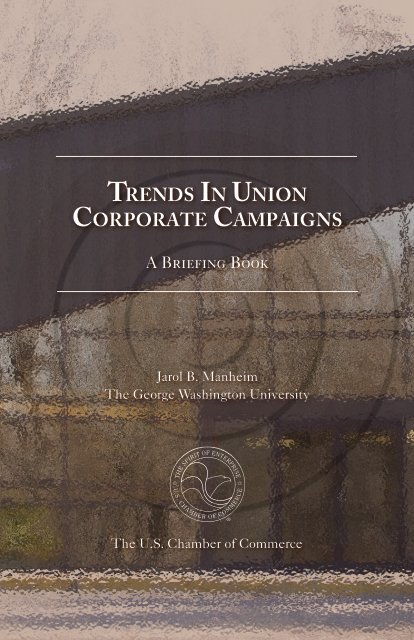


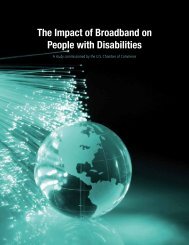
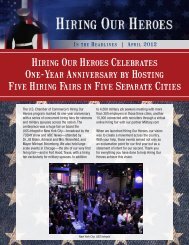
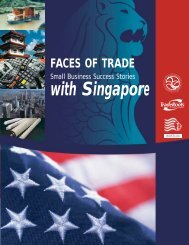

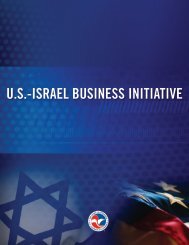
![[PDF] A Response by the International Organisation of Employers to ...](https://img.yumpu.com/41807569/1/184x260/pdf-a-response-by-the-international-organisation-of-employers-to-.jpg?quality=85)
